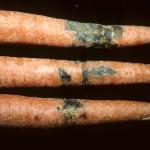Carrot, Black Root Rot
Thielaviopsis basicola
Black Root rot of carrot, caused by Thielaviopsis basicola, is primarily a post harvest disease. The pathogen occurs worldwide and has a wide host range, including plants in the legume, potato, and cucurbit families, as well as numerous ornamentals and woody plants. The disease occasionally occurs on seedlings or mature carrots in the field and is more serious on soils with high organic matter content.
Identification:
T. basicola are superficial, irregular black lesions which occur in a random pattern. The discoloration is limited to the epidermis and the black coloration is masses of dark brown to black chlamydospores. The pathogen rapidly invades wounded tissue and is favored by long post harvest periods without cooling.
Life Cycle:
T. basicola persists in the soil as chlamydospores and is favored by alkaline pH. Survival spores germinate in response to root exudates from crop plants and infect through wounds or natural openings.
Crop Injury:
Severe infection of roots can cause wilting, stunting, and loss of productivity, but most injury occurs because of lack of marketability of affected carrots.
Cultural Controls & Prevention:
Maintaining soil pH at 5.5 will reduce initial infections.As this disease occurs primarily after harvest and mechanical grading, avoiding wounding and the prompt removal of field heat are necessary control measures. T. basicola is rarely serious problem under optimum storage conditions (0-1˚ C).Good disease control can be obtained when harvested carrots are dipped in chlorinated, hydrocooled water or solutions of potassium sorbate and propionic acid.
Chemical Controls & Pesticides:
For Current information on disease recommendations ins specific crops including information on chemical control & pesticide management, please visit the New England Vegetable Management Guide website.
Crops that are affected by this disease:
The Center for Agriculture, Food and the Environment and UMass Extension are equal opportunity providers and employers, United States Department of Agriculture cooperating. Contact your local Extension office for information on disability accommodations. Contact the State Center Director’s Office if you have concerns related to discrimination, 413-545-4800 or see ag.umass.edu/civil-rights-information.

